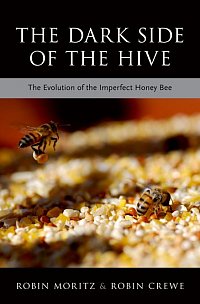2016-2018
Publication year: 2016
How to access a password protected publication:
Because of copyright restrictions of some publishers, only interested colleagues may download the paper by using the appropriate password, which is the scientific name for the genus honeybee. You will then be able to download the authors copy of the publication. By downloading you agree not to sell or reproduce the article or any part of it for commercial purposes (i.e. for monetary gain on your own account or on that of a third party, or for indirect financial gain by a commercial entity).
The arrow link will direct you to the original publication of the publisher. The PDF link will guide you to a password protected author's copy.
In case of problems, do not hesitate to contact us.
2018

Aumer D, Mumoki FN, Pirk CWW, Moritz RFA (2018): The transriptomic changes associated with the development of social parasitism in the honeybee Apis mellifera capensis. Sci Nat 105: 22.
Aumer_etal_2018_SciNat.pdf
(1.2 MB) vom 22.03.2018
Buttstedt A, Mureşan CI, Lilie H, Hause G, Ihling CH, Schulze S-H, Pietzsch M, Moritz RFA (2018): How honeybees defy gravity with royal jelly to raise queens. Curr Biol 28: 1-6
Buttstedt_etal_2018_CurrBiol.pdf
(1.7 MB) vom 22.03.2018
Conlon BH, Frey E, Rosenkranz P, Locke B, Moritz RFA, Routtu J (2018): The role of epistatic interactions underpinning resistance to parasitic Varroa mites in haploid honey bee (Apis mellifera) drones. JEB .
Conlon_etal_2018-JEB.pdf
(328.9 KB) vom 30.05.2018
Erler S, Lewkowski O, Poehlein A, Forsgren A (2018): The curious case of Achromobacter eurydice, a Gram-variable pleomorphic bacterium associated with European foulbrood disease in honeybees. Microb Ecol , (early online).
Erler_etal_2017_MicrobEcol.pdf
(13.1 MB) vom 21.06.2017
Kurze C, Le Conte Y, Kryger P, Lewkowski O, Müller T, Moritz RFA (2018): Infection dynamics of Nosema ceranae in honey bee midgut and host cell apoptosis. JIP 154: 1-4
Kurze_etal_2018_JIP.pdf
(216.9 KB) vom 22.03.2018
2017
Aumer D, Allsopp MH, Lattorff HMG, Moritz RFA, Jarosch-Perlow A (2017): Thelytoky in Cape honeybees (Apis mellifera capensis) is controlled by a single recessive locus. Apidologie 48: 401-410.
Aumer_etal_2017_Apido.pdf
(16 MB) vom 25.01.2017
Beaurepaire AL, Krieger KJ, Moritz RFA (2017): Seasonal cycle of inbreeding and recombination of the parasitic mite Varroa destructor in honeybee colonies and its implications for the selection of acaricide resistance. Infect Genet Evol 50: 49-54.
Beaurepaire_etal_2017_InfGenEvol.pdf
(671.5 KB) vom 15.03.2017
Doublet V, ..., Moritz RFA, et al. (2017): Unity in defence: honeybee workers exhibit conserved molecular responses to diverse pathogens. BMC Genomics 18: 207
Doublet_etal_2017_BMC-Genomics.pdf
(3.5 MB) vom 21.09.2017
Forfert N, Moritz RFA (2017): Thiacloprid alters social interactions among honey bee workers (Apis mellifera) . J Apicult Res 56 : 467-474.
Forfert_Moritz_2017_JAR.pdf
(1.6 MB) vom 21.09.2017
Helbing S, Lattorff HMG, Moritz RFA, Buttstedt A (2017): Comparative analyses of the major royal jelly protein gene cluster in three Apis species with long amplicon sequencing. DNA Res 24: 279-287.
Helbing_etal_2017_DNA-Res.pdf
(449.4 KB) vom 21.09.2017
Pieplow JT, Brauße J, van Praagh JP, Moritz RFA, Erler S (2017): A scientific note on using large mixed sperm samples in instrumental insemination of honeybee queens. Apidologie 48: 716-718.
Pieplow_etal_2017_Apido.pdf
(4.3 MB) vom 21.06.2017
Pirk CWW, Crewe RM, Moritz RFA (2017): Risks and benefits of the biological interface between managed and wild bee pollinators. Funct Ecol 31: 47-55.
Pirk_etal_2017_Funct_Ecol.pdf
(691 KB) vom 21.09.2017
Koeniger N , Kurze C, Phiancharoen M, Koeniger G (2017): “Up” or “down” that makes the difference. How giant honeybees (Apis dorsata) see the world. PLoS ONE 12(11): e0185325.
Koeniger_etal_2017_PLOSone.pdf
(17.4 MB) vom 22.03.2018
Soro A, Quezada-Euan JJG, Theodorou P, Moritz RFA, Paxton RJ (2017): The population genetics of two orchid bees suggests high dispersal, low diploid male production and only an effect of island isolation in lowering genetic diversity. Conserv Genet 18: 607-619.
Soro_etal_2017_ConservGenet.pdf
(745.4 KB) vom 21.09.2017
2016
Aurori AC, Bobis O, Dezmirean DS, Marghitas LA, Erler S (2016): Bay laurel (Laurus nobilis) as potential antiviral treatment in naturally BQCV infected honeybees. Virus Res 222: 29-33.
Aurori_etal_2016_VirusRes.pdf
(361.4 KB) vom 11.08.2016
Buttstedt A, Ihling CH, Pietzsch M, Moritz RFA (2016): Royalactin is not a royal making of a queen. Nature 537 (7621): E10-E12. Link.
please use the nature-link.pdf
(26.8 KB) vom 15.03.2017
Doublet V, Paxton RJ, McDonnell CM, Dubois E, Nidelet S, Moritz RFA, Alaux C, Le Conte Y (2016): Brain transcriptomes of honey bees (Apis mellifera) experimentally infected by two pathogens: Black queen cell virus and Nosema ceranae. Genomics Data 10: 79-82
Doublet_etal_2016_Genomics-Data.pdf
(308.7 KB) vom 21.09.2017
EPILOBEE Consortium et. al. (2016): Risk indicators affecting honeybee colony survival in Europe: one year of surveillance. Apidologie 47 (3): 348-378.
Epilobee Consortium_etal_2016-Apido.pdf
(2.4 MB) vom 10.10.2018
Erler S, Moritz RFA (2016): Pharmacophagy and pharmacophory: mechanisms of self-medication and disease prevention in the honeybee colony (Apis mellifera). Apidologie 47:389-411.
Erler_Moritz_2016_Apidologie.pdf
(698.3 KB) vom 11.08.2016
Forfert N, Natsopoulou ME, Paxton RJ, Moritz RFA (2016): Viral prevalence increases with regional colony abundance in honey bee drones (Apis mellifera L). Infect Genet Evol 44: 549–554.
Forfert_etal_2016_InfectGenetEvol.pdf
(346.7 KB) vom 21.09.2017
Fouks B, Lattorff HMG (2016): Contrasting evolutionary rates between social and parasitic bumblebees for three social effect genes. Font Ecol Evol 4: 1-9
Fouks_Lattorff_2016_FrontEcolEvol.pdf
(486.1 KB) vom 11.08.2016
Helbing S, Lattorff HMG (2016): Patterns of molecular evolution of RNAi genes in social and socially parasitic bumblebees. Infect Genet Evol 42: 53-59.
Helbing_Lattorff_2016_InfectGenetEvol.pdf
(525.9 KB) vom 20.05.2016
Kidner J, Moritz RFA (2016): Conditions for the invasion of male-haploidy in diploid populations. J Evol Biol .
Kidner_etal_2016_JEB.pdf
(360.5 KB) vom 11.08.2016
Kurze C, Dosselli R, Grassl J, Le Conte Y, Kryger P, Baer B, Moritz RFA (2016): Differential proteomics reveals novel insights into Nosema-honey bee interactions. Insect Biochem Molec 79: 42-49.
Kurze_etal_2016_Insect-Biochem-Molec.pdf
(716.1 KB) vom 21.09.2017
Kurze C, Mayack C, Hirche F, Stangl GI, Le Conte Y, Kryger P, and Moritz RFA (2016): Nosema spp. infection causes no energetic stress in tolerant honeybees. Parasitol Res 1-8.
Kurze_etal_2016_ParasitolRes.pdf
(407.8 KB) vom 04.04.2016
Kurze C, Routtu J, and Moritz RFA (2016): Parasite resistance and tolerance in honeybees at the individual and social level. Zoology 119: 290-297.
Kurze_etal_2016_Zoology.pdf
(711.7 KB) vom 04.04.2016
Lattorff HMG, Moritz RFA (2016): Context dependent bias in honeybee queen selection: swarm versus emergency queens. Behav Ecol Sociobiol
Lattorf_Moritz_2016_BES.pdf
(254.4 KB) vom 20.05.2016
Lattorff HMG, Popp M, Parsche S, Helbing S, Erler S (2016): Effective population size as a driver for divergence of anantimicrobial peptide (Hymenoptaecin) in two common European bumblebee species. Biol J Linn Soc 119(2): 299-310.
Lattorff_etal_2016_BiolJLinnSoc.pdf
(219.8 KB) vom 21.06.2017
Margaoan R, Zahan M, Marghitas LA, Dezmirean DS, Erler S, Bobis O (2016): Antiproliferative activity and apoptotic effects of Filipendula ulmaria pollen against C26 mice colon tumour cells. J Apic Sci 60: 135-144.
Margaoan_etal_2016_JApicSci.pdf
(1003.2 KB) vom 11.08.2016
Moritz RFA, Erler S (2016): Lost colonies found in a data mine: Global honey trade but not pests or pesticides as a major cause of regional honeybee colony declines. Agr Ecosyst Environ 216: 44-50.
Moritz_Erler_2016_ AgricEcosysEnviron.pdf
(765.4 KB) vom 09.10.2015
Rueppell O, Aumer D, Moritz RFA (2016): Ties between ageing plasticity and reproductive physiology in honey bees (Apis mellifera) reveal a positive relation between fecundity and longevity as consequence of advanced social evolution. Curr Opin Insect Sci 16: 64-68.
Rueppell_etal_2016_CurrOpinInsectSci.pdf
(307.6 KB) vom 21.09.2017
Vezeteu TV, Bobiş O, Moritz RFA, Buttstedt A (2016): Food to some, poison to others - honeybee royal jelly and its growth inhibiting effect on European Foulbrood bacteria. MicrobiologyOpen early online .
Vezeteu_etal_2016_MicrobiologyOpen.pdf
(440.7 KB) vom 30.11.2016



